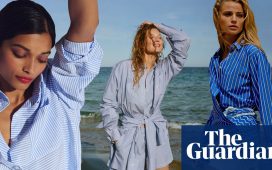Anya Taylor-Joy in 90s Paco Rabanne, pierced on all sides with arrows, a foil to sitting down. Sydney Sweeney in a Balmain top crafted with dozens of white flowers, grapes and hands. Gwen Stefani in a custom resin dress that looks like a big piece of snapped-off caramel lattice.
From dresses adorned with entire bouquets of metal flowers to shoulder straps that float a couple of inches above the actual shoulder, sculptural garments have been taking over red carpets and magazine covers of late.
It has been brewing for a while. The surrealist look sported by Sweeney on the red carpet was first seen on Naomi Campbell as she closed Balmain’s show at Paris fashion week in February wearing a gilded gold version. At the Grammys, singer Dawn Richard’s dress, by the Armenian designer Khosrov, sprouted branches and leaves, while at the Golden Globes, Poker Face actor Natasha Lyonne wore an architectural Schiaparelli tassel gown that looked like a bridge.
The Oscars this year was also host to a bevy of looks that were part-high art, part-high fashion. Oppenheimer co-stars Florence Pugh and Emily Blunt divided the internet with their floating shoulder straps, with the comedian Sarah Colonna joking on X: “Find someone who will respect your personal space the way the straps on Emily Blunt’s dress respects hers.” While, of course, the Met this week saw more than its fair share of mould-breaking silhouettes.
But garments that look like a De Stijl aren’t just the preserve of the elite. Look to the high street for asymmetric statuesque dresses at Mango, sculpted bustier designs at Reiss and applique tops that look like a bunch of silky peonies. This isn’t about the exaggerated silhouettes and flounce that took over fashion in recent years, but something altogether more directional; more Jean Arp curves or jagged Louise Bourgeois lines than frothy layers of tulle.
Allow Instagram content?
This article includes content provided by Instagram. We ask for your permission before anything is loaded, as they may be using cookies and other technologies. To view this content, click ‘Allow and continue’.
These sculptural designs are the perfect antidote to a digital world flattened and homogenised by filters. “We are totally digital [when it comes to] presentation of fashion. There’s no skin feeling because it’s always on Instagram,” says French artist Jeanne Vicerial, whose textile sculptures are currently on show at the Musée du Vieux Nîmes. Over the past century, industrialisation, mass-production, and now, technology, have radically transformed the fashion industry, and it means that “we have lost the connection with fabric.”
These sometimes architectural clothes can also be interpreted as a byproduct of the chaotic socio-political period we’re living in. “During tough times, fashion trends may veer towards maximalism, with exaggerated silhouettes, vibrant colours, and embellishments as we seek to find joy and liberation amid adversity,” says Carolyn Mair, author of the Psychology of Fashion.
It’s not the first time we’ve seen such outfits surge in popularity. Mair defines the years after the first world war, as “a period of artistic experimentation and cultural change,” most notably seen in the surrealist and dadaist movements. During this time, “Schiaparelli and Balenciaga created sculptural garments that challenged traditional silhouettes,” in a similar way that artists such as Salvador Dalí, Jean Cocteau and Man Ray pushed at the oppressive boundaries of rationalism.
“Choosing bigger and bolder outfits in times of economic uncertainty or social upheaval can serve as armour,” she says, “temporarily protecting us from reality, allowing us to escape through outfits that provide a sense of power, confidence and resilience.”














